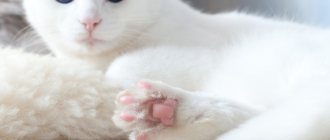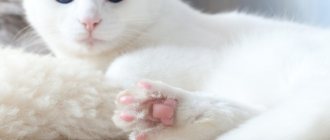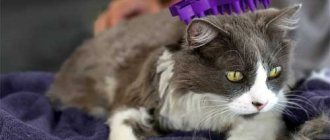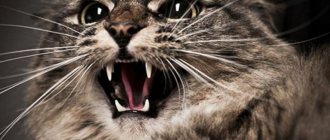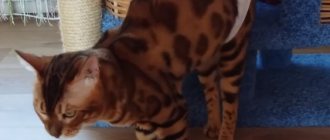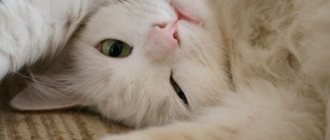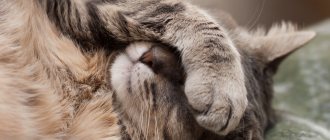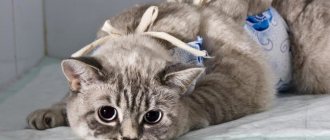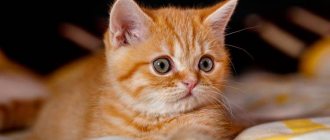Causes of lameness in cats
Lameness is a violation of the motor function of an animal, in which there is incomplete contact of one of the limbs with the ground. In this case, the body weight is transferred to healthy paws. The owner may notice stiffness of movement, uneven, slow gait. The animal refuses to perform usual movements (jumping on the sofa, jumping from a height). The cat does not allow the affected limb to be stroked and constantly licks it.
Veterinary experts note many reasons why a cat stops leaning on one of its limbs and begins to limp:
- Long claws
. Untimely cat claws result in excessively long claws interfering with the normal support of the limbs when the animal moves.
In addition, the claw can grow into the soft tissue of the paw, causing pain and leading to lameness.
- A common reason for a cat to have a lame paw is a splinter
. Fluffy fidgets love to climb trees. Such fun often leads to sharp wooden splinters getting stuck in the delicate tissues of the cat's paw. Having stuck into the paw of an animal, the splinter causes pain and discomfort when moving, changing the gait. - The causes of sudden lameness in a pet are most often injuries such as bruises, dislocations, sprains and torn ligaments.
The activity of an animal often plays a cruel joke on it. Jumping from heights is a common cause of sprains and tears of the cruciate ligament. Limb injuries are observed in free-ranging cats.
Running away from dogs, participating in fights with relatives, climbing trees and hills, furry pets are often exposed to bruises and problems with the ligamentous apparatus. The most common traumatic dislocations are observed in the hip, elbow and wrist joints.
- A more serious cause of severe lameness is a broken limb
. In this case, the owner can observe not only the presence of lameness in the animal, but also the dragging of the injured paw. As a rule, the animal tries not to step on the broken limb due to severe pain and holds it suspended.
- The owner often observes the cat limping after an injection
. This phenomenon is temporary and is due to the fact that during the injection the needle was inserted too deep into the muscles. After a few hours, the lameness caused by the intramuscular injection stops. - A persistent problem in a young animal may be caused by a genetic disease - hip dysplasia
. This pathology of the musculoskeletal system occurs in many breeds of domestic cats and is a negative sign that breeders should get rid of. With dysplasia in cats, the owner may observe that the cat is limping on its hind leg.
As a rule, strong changes in a pet's gait can be observed at the moment when the animal begins to move after sleep or rest. As you walk, the severity of lameness decreases. Fast-growing cat breeds, such as Maine Coon, British and Bengal cats, are predisposed to this disease.
- In the first stages of the viral disease calcivirosis,
the owner may observe the so-called lameness syndrome. At the same time, the pet also notices increased joint pain. This is due to the localization of the calcivirosis virus in the connective tissue of the joints. - Osteodystrophy
is another cause that occurs when phosphorus-calcium metabolism and vitamin D absorption are impaired. Softening and deformation of bones develop, which leads to gait disturbances and lameness. Breeds such as Scottish Fold and Scottish Straight are susceptible to the disease. - and arthrosis
are common causes of lameness in older animals over 7 years of age. In addition to the pronounced symptom, the elderly pet experiences swelling of the joints, increased local temperature, and pain when palpated. - A serious reason why the cat began to limp constantly could be oncological pathology - osteosarcoma
. Most often, the disease develops after 6–7 years.
The variety of factors leading to lameness must be taken into account by the owner when detecting this phenomenon in a pet.
Common diseases
A predisposition to a disease may remain only a hereditary tendency, but sometimes it leads to the development of dangerous and even fatal pathologies. Genetic diseases of Scottish cats include osteochondrodystrophy and hemophilia B type.
The owner of a lop-eared pet may not be aware of the latter until injuries occur or a planned operation is performed.
Hemophilia is characterized by impaired blood clotting due to a lack of fibrin and increased bleeding in cases of damage to the integrity of the skin, oral and nasal mucosa.
The damaged area is not covered with a protective crust, which can lead to the death of the animal from blood loss.
Osteochondrodystrophy in cats
Cats with OCD do not jump, walk stiffly on stiff legs, or limp. Their external structure is characterized by a large head, a curved jaw, a thick tail that cannot move, and short limbs with swollen or deformed joints.
Disorders of skeletal motor function occur due to a defect in the development of cartilage tissue, leading to progressive osteoarthritis.
An incorrect ossification process in kittens leads to dwarfism and deformations of the bones of the peripheral and axial skeleton; the animal hardly grows, and over time acquires a squat appearance. Pet owners may not immediately notice the manifestations of the disease, since Scottish Fold cats have a small body weight and can redistribute the load from diseased paws to healthy ones.
What should the owner do?
Having noticed an uncertain, shaky gait in a furry beauty, the owner must take measures to identify the factors that led to lameness. First of all, it is necessary to examine the sore paw for the presence of foreign bodies in it: splinters, splinters, glass, etc.
If a cat is limping on a front paw, it is necessary to examine and feel the soft tissues of the limb to find out if there are ingrown nails that are interfering with the normal movement of the animal. If overgrown claws are detected, trimming them at home will return the pet to a normal gait.
After examining the paw pads, the injured limb should be carefully examined. , open fractures are easy to notice during visual inspection. In the absence of visible damage, you should feel the joints of the affected limb for swelling, swelling, pain, and increased local temperature.
If a cat has a sore paw, is limping and has dragging limbs, viral calcivirus should be ruled out. With this disease, in addition to gait disturbances, nasal discharge, sneezing, and conjunctivitis are observed. You should not diagnose your pet on your own. Only a veterinarian can determine that lameness is caused by a viral infection based on laboratory tests.
If the problem is not related to a splinter, wound, or visible damage, the owner should take the limping cat to a specialized facility. The most reliable method for diagnosing hidden injuries of joints and bones is x-ray examination.
Using an x-ray, a veterinarian will see displacement of bones during a fracture, dislocations, ruptures of ligaments, disruption of the normal configuration in the joint, phenomena of hip dysplasia and other pathologies of the musculoskeletal system. This method is painless and can be performed in some cases without anesthesia, with light sedation of the animal.
We recommend reading about. You will learn about congenital and acquired heart diseases, symptoms and signs that the owner should pay attention to, diagnosis, treatment and prevention. And more about what to do if your cat has severe salivation.
Prevention and therapy
Proper nutrition plays an important role in the treatment and prevention of all forms of arthritis. This pathology, first of all, is the deposition of calcium in cartilage and joints. It occurs as a result of excessive consumption of canned food, cereals and baked goods.
. In short, this is another reason to completely reconsider the diet of your “fluffy”. The success of treating and preventing arthritis largely depends on a balanced diet. The daily diet (especially for old cats) should include boiled and pureed vegetables, but fatty meat, canned food and “handouts” should be completely excluded from the human table.
Treatment Options
The owner can help the pet on his own only if he discovers an overgrown nail, a splinter, or a small wound on a limb. If lameness is caused by a wound, the wound surface should be thoroughly cleaned of contamination and treated with a disinfectant solution. Even with minor damage to the skin, the animal should be shown to a veterinarian.
If a dislocation is suspected as the cause of the lameness, under no circumstances should you adjust it yourself. If a cat has a swollen paw or is limping, the pet should be taken to a veterinarian immediately.
This should be done quickly, as swollen tissues make it difficult to diagnose and reduce the dislocation. In a clinical setting, if necessary, the animal will be given anesthesia to relieve pain and relieve muscle spasm, and the dislocated joint will be set back into place. After this manipulation, the cat will be given a fixing bandage or splint. In some cases, for dislocations, surgical treatment is resorted to.
For fractures, veterinary specialists use immobilizing bandages and apply plaster. In the case of an open fracture, bone fragments are removed from the wound and, if necessary, surgical excision of the damaged tissue is performed.
Treatment of hip dysplasia and arthrosis of certain joints at first is conservative in nature and includes the use of anti-inflammatory drugs, vitamins, and chondroprotectors. Massage and physiotherapy provide good results. For exacerbations, painkillers are used.
For lameness caused by antiviral and antibacterial therapy. In case of osteodystrophy, the sick pet is prescribed mineral supplements of calcium and phosphorus, vitamin D. Correction of the animal’s diet and dosed ultraviolet irradiation have a good effect.
Arthritis requires complex treatment, which is based on anti-inflammatory, antibacterial agents and painkillers. An important role in the treatment of inflammatory phenomena in the joint is played by adherence to a special therapeutic diet.
If you notice lameness in your pet, you should not hesitate to visit a veterinarian, and also self-medicate. The phenomenon associated with gait disturbance can be caused by serious reasons (dislocations, fractures, joint dysplasia) that require professional help.
X-rays help make a correct diagnosis of a sick animal. In severe cases, veterinary specialists resort not only to conservative treatment, but also to surgery on the joint.
To learn how osteosynthesis is used to treat a tibia fracture in a cat, watch this video:
Sudden lameness in a pet can be caused by various reasons, from simple damage to the pads to joint pathologies. It is impossible to determine exactly why a cat is limping on its front leg without taking an x-ray of the affected limb.
The obvious cause of lameness is injury to a pet's paw. A cat can protect a limb for the following reasons:
- Splinter in the paw pad.
- Injury.
- Sprain.
- Damage to claws.
It is important to try to recall in memory all the events preceding the onset of lameness. If the cat fought with other animals or fell from a great height, the paw hurts due to a bruise or sprain.
A splinter caught in the foot pad can cause severe discomfort. In this case, the cat cannot remove a small foreign body on its own. Since acute pain is felt when putting pressure on the damaged paw, the animal begins to protect it, which is why lameness appears.
The cat does not step on its front paw due to damaged claws. This can also happen if you fall from a great height or get hit. In addition, if someone accidentally steps on a cat's paw, the claw may be broken, which causes the animal a lot of discomfort.
Arthritis and arthrosis
Arthrytis () translated from Greek means “joint inflammation.” This is one of the most common pathologies that affects old cats everywhere. Arthritis that affects one joint is called monoarthritis in veterinary medicine.
disease of two or three joints -
oligoarthritis.
If not one or two, but all joints of the limbs suffer, then the name of the diagnosis changes -
polyarthritis
. What is it? This is the name of an inflammatory-degenerative disease, which is generally characterized by the same pathological changes in the joints.
But its essence does not change. The joints do not hurt as much without movement, without stress on them, but more so with stress and active games. In this case, the cat becomes very weak, completely or partially refuses to eat, and the body temperature may rise. Arthritis affects not only the joints, but also the internal organs. Among the main reasons leading to the development of the disease, veterinarians identify the following factors:
- Heredity
, about which we have already written a lot above.
- A “lying down” lifestyle,
that is, pathology very often affects castrates who are prone to low activity and rapid weight gain. If a “well-fed” cat begins to constantly fall on its front paw, it should be taken to the doctor immediately.
- Unbalanced diet.
This is typical for pets whose owners “don’t bother” with choosing the right, complete diet.
- We can also mention our ecology,
which has a detrimental effect on the health of not only humans, but also their pets.
- Various infections
.
Infectious causes of lameness
Damage to the front paws and lameness are characteristic symptoms of calcivirosis. A disease of an infectious nature is easily transmitted from a sick animal to a healthy one. Pets are usually vaccinated against this disease, but vaccination is not always sufficiently effective, so the animal remains at risk of infection throughout its life.
Symptoms of the disease:
- Breathing disorders;
- Nasal discharge;
- Conjunctivitis;
- Ulcers on the mucous membranes;
- Damage to the joints of the paws.
Calcivirosis is often accompanied by arthritis, which causes lameness. This disease causes inflammation of the joint capsule and manifests itself mainly on the front legs.
Another cause of sudden lameness is a fungal infection. Dermatophytes can affect not only the skin of the animal, but also the claws and joints. The fungus on the pads may not be visible externally if the pathogenic microflora affects the joint. Against this background, inflammation develops, as a result of which the cat limps on its front leg.
Diagnosis of cat lameness
What to do if you find a cat with lameness on the front or back leg? First, do not delay visiting a veterinary clinic or office. If the cause is an infectious disease, then delay in treatment can cost not only the animal’s health, but also its life. During the visit, the veterinarian will perform the following diagnostic measures:
- will look at the patient's medical history (if any). He will conduct a survey of the owner, find out whether the animal has had any injuries recently, and find out about the presence of accompanying symptoms, in addition to lameness;
- visual inspection of a limping cat. It is necessary to understand how serious the lameness is, the location of the most painful area of the limb, and the presence of abnormal places in the structure of the joints. The doctor will look at how the animal moves, runs, stands;
- neurological examination. It is carried out to exclude damage to the central nervous system, muscles, brain or spinal cord, because lameness is not always caused by orthopedic problems;
- radiograph. It will help you see the presence of cracks, tumors, growths and other problems inside the limb.
You may also need to take tests of synovial fluid, general blood and biopsy, and urine. With the introduction of the dye, studies of the spinal canal are performed - myelography. Contrast radiography or arthrography (injection of dye into the joint) is done using the same method. Ultrasound, MRI and CT may be prescribed.
Joint diseases
Lameness can be caused by a congenital abnormality of the structure of the joints - dysplasia. In this case, the animal will have difficulty stepping on the affected limb from childhood. Other joint pathologies include arthritis and degenerative changes in the joints of the front paws. As a rule, such diseases are rare and mainly occur in older cats with metabolic disorders, acromegaly or obesity.
Symptoms indicating problems with the front paw of a pet:
- Change in gait.
- Refusal to jump on chairs and other surfaces.
- Lethargy.
- Frequent licking of the sore limb.
When the owner tries to touch the sore paw, the cat reacts sharply, pulling it away, running away or hissing. If this condition persists for more than a few days, you should contact your veterinarian as soon as possible. To make a diagnosis, the doctor will palpate and examine the affected limb. Radiography is mandatory.
Predisposing factors and how to combat them
Currently, not everything is known about the causes of arthritis. It has many varieties, among which it should be noted: osteoarthritis, gout and rheumatoid arthritis
. Each type has its own characteristic features, but at the same time, there is also a lot in common between them: pain when moving, severe lameness, inflammatory processes. The latter (in especially advanced cases) can lead to the development of sepsis and complete destruction of the joints.
There is also “occupational” arthritis. This type of pathology is characterized by the fact that pathological changes in the joints occur as a result of many years of repeated stress on the limbs. For example, chronic arthritis can occur (due to the specifics of the “profession”) in circus cats. But this, of course, is truly exotic. Much more often, the causes of arthritis and the lameness it causes are much more commonplace.
Often the disease is provoked by a cold infection, severe bruises and bites in the joint area
, constant contact with toxic substances. Sometimes an exclusively fish or “dry” (that is, the cat is fed only dry food) diet contributes to joint disease. Rare cases of psychosomatic arthritis appearing in particularly sensitive pets against a background of serious ones (after sterilization, for example) have been described.
How does the disease manifest? The cat begins to limp heavily, every movement causes her severe pain. The joints may become noticeably swollen, and when palpated, it is easy to notice an increase in local body temperature. As a rule, animals react aggressively to attempts to probe them: they meow hoarsely, try to scratch the owner and run away.
Treatment of lameness in cats
First of all, if you notice that the cat cannot step on its front paw, you should carefully examine the limb. Any damage to the foot pads, claws, or the appearance of rough crusts indicate the traumatic nature of the lameness.
As a rule, when a splinter gets into a soft pad, it makes itself felt over time with swelling or inflammation. In this case, it is enough to remove the foreign body with tweezers and treat the wound with an antiseptic to help your pet. After a few days, the wound will heal and the cat will stop limping.
You can suspect a bruise or sprain by the cat's behavior. In these cases, the animal will drag its paw, trying not to step on it. If the joints are affected, the cat walks normally, but redistributes its body weight in such a way as to minimize the load on the affected limb.
Treatment of degenerative changes and age-related arthritis in cats is carried out with the help of drugs that restore the elasticity of cartilage. Such medications can only be prescribed by a veterinarian. If joint pathologies are caused by excess weight and metabolic disorders, the animal is prescribed a strict diet to normalize body weight.
In other cases, symptomatic therapy is used. The exact treatment regimen depends on the cause of lameness, which can only be reliably determined by x-ray.
Is your Scottish Fold or Straight cat limping on a front or back leg? Let's look at the most common reasons why your kitten or adult cat is limping.
why does a cat limp on his front leg?
Kitten limps on its paw
If your kitten is limping on one leg
there may be several reasons. First, make sure that the kitten has not pricked its paw. Have your baby sit on your knees and carefully examine the paw pads. If you find no cut, scratch, or foreign body, we continue the inspection.
If your kitten has a scratched paw pad or a foreign body (splinter) stuck there, treat it with chlorhehysidine and call your veterinarian who will advise you on treating the wound.
Remember if your fidget jumped from a height; perhaps he landed unsuccessfully. There are several options: a simple bruise, which will go away on its own over time, a sprain, a crack, and even a fracture, which require immediate medical attention. So if a kitten is limping on its paw due to an unsuccessful fall from a height, give it an injection of traumatin (0.5 ml subcutaneously) and immediately consult a doctor. Usually the doctor takes an x-ray to find out the extent of the injury and, depending on the result of the x-ray of the kitten's lame paw, prescribes treatment.
If the kitten’s paw pads are intact and he did not jump from a height, pay attention to the kitten’s well-being. Perhaps the kitten is limping on its paw due to an infectious disease
Infectious diseases such as calcevirosis can cause lameness in a kitten. In the article “Infectious diseases in cats and kittens” and “If a cat is sick” you will find descriptions of signs of serious diseases in a kitten. If you suspect at least one of the diseases due to which the kitten is limping on its paw, urgently take the baby to the doctor.
There are many diseases and reasons why a kitten is limping on its paw, so the sooner you contact a veterinarian, the faster your baby will receive help, and possibly save his life.
Lameness after injection
After an injection that hits a nerve, the cat may begin to limp. That’s why it’s so important to give your cat injections correctly, although sometimes even veterinarians make mistakes. Usually the lameness caused by the injection goes away within a few days. If lameness after the injection lasts longer than a week, you need to see a veterinarian.
Also, lameness can be observed after an injection of no-shpa, but not due to a hit on the nerve, but due to a muscle cut that this drug can cause. Paresis may go away in a few weeks, but it may not go away at all. True, in the case of paresis of the limbs, the cat will not so much limp as drag its paws. In any case, you need to go to the veterinary clinic and confirm the diagnosis.
Symptoms of lameness
An animal can limp with varying degrees of severity. Some slightly twist their paw when walking, others cannot step on it at all. Observe your pet, conduct a visual examination and run to the doctor if you notice at least one of the following signs:
- the cat cannot walk at all or moves with difficulty;
- after touching the paw, the cat pulls it away and begins to whine;
- refuses to go outside, especially if you have to go up or down stairs;
- the animal does not stand on its paw;
- with a fungal infection, a trace of dermatophytes is visible on the paws.
In addition to physical signs, your cat may lose appetite, become tired, lethargic, or irritable. If you forcefully examine a painful limb, the cat may hiss and even claw you.
Lameness due to injury
By injuries we do not necessarily mean sprains, fractures or dislocations. It could be a simple wound on the pad of the paw. The pain associated with such a wound may be unpleasant for the cat - and it will begin to spare the paw.
However, if there are no visible injuries, check the cat's reaction by feeling its entire paw - carefully and gently, but with pressure. Perhaps it is a matter of deep trauma. If your cat reacts painfully to touch in a particular place, you should go to the veterinarian. He will take an x-ray to find out the real reason. Moreover, sometimes wounds are observed not because of splinters, insect bites and injuries, but because of the disease described below. This disease is dangerous, and therefore an accurate diagnosis must be made as early as possible.
First aid for a cat
If you notice that your cat is limping, you need to immediately identify the cause. Having discovered a wound, the first thing to do is disinfect it. If possible, remove hair around the damage and rinse with furatsilin solution.
Limit access of dirt to the wound, apply a bandage and contact a veterinarian.
If you suspect a dislocation, sprain or fracture, provide your pet with maximum rest, give painkillers and cardiac medications, and call a doctor.
X-ray of the hind paw.
The clinic needs to take an x-ray
. If necessary, apply a fixing bandage. The fracture is fixed by applying a splint or plaster cast. Antibiotics and anti-inflammatory drugs are used.
Arthritis treatment
Treatment of arthritis includes taking antibiotics in the form of a dietary supplement - glucosamine, chondroitin.
Taking fish oil and painkillers. A light massage and daily short exercise are indicated. Animals with arthrosis are provided with dietary nutrition and comfortable living conditions.
Drug treatment
– decongestants, anti-inflammatory drugs – in the presence of inflammation. Massage, Minin lamp therapy. For severe back injuries, the prognosis is, unfortunately, unfavorable. The animal experiences severe pain, and sometimes limb paralysis is observed.
Lameness due to osteochondrodysplasia
In the case of lameness in a Scottish cat, the possibility of osteochondrodysplasia cannot be excluded. This disease is associated with changes in the structure of the musculoskeletal system; it affects fold-eared cats, which may be carriers of the defective gene. Read more about this disease in another article. Here we will say that the disease is incurable and can significantly ruin the pet’s quality of life, so a symptom such as lameness cannot be ignored. You need to go to the vet and get a diagnosis. The sooner treatment begins, the greater the chance of salvation.
The effect of feline calicivirus infection on joints.
Further studies showed that calicivirus proteins could be found in the synovium (the membrane lining the surface of the joint cavity and the ligaments located in the joint) in cats infected with or vaccinated with the live FCV vaccine. Since viral proteins are associated with antibodies, we can talk about the formation of an “immune complex” (a combination of a virus protein and specific antibodies produced against it), which can provoke an inflammatory reaction. In some cases, the entire virus was isolated from the joints of cats with signs of calicivirus infection, including lameness, which can be considered evidence that the virus provoked an acute inflammatory reaction.
It is therefore clear that exposure to calicivirus, at least in some situations, results in a systemic infection causing localization of the virus in the joint tissues, which may cause an inflammatory response due to local replication in these areas, or perhaps due to stimulation of the immune system. mediated inflammation. Claudication syndrome is a form of virally induced polyarthritis (inflammation affecting multiple joints).
Some strains of FCV appear to be more likely to cause lameness in cats than others.
Treatment of lameness in cats
Treatment for lameness in cats depends on the cause. Depending on this, either only painkillers, or courses of antibiotics, or anti-inflammatory drugs, etc. will be prescribed. In some situations, complete healing will not be possible, but the cat's condition can be maintained at the proper level. In any case, we recommend that you do not do this yourself, but go to the veterinary clinic. If your pet is given a terrible diagnosis, you need to recheck it in another clinic, without initially saying that you already know the opinion of another doctor.
Lameness - A cat is considered lame if it is unable to walk normally or cannot support itself on one or more paws.
Lameness in cats. Causes.
Lameness is most likely not an independent disease, but symptoms of other hidden diseases, most of which cause pain to the cat.
Often, lameness is caused by foreign bodies (grass seeds, plant thorns) that dig into the paw pads, and these can also be cuts or wounds received in a fight with other cats. Another cause of lameness may be a disease of the claws or nerves that affect the sensitivity of the paws.
Lameness in cats. General symptoms.
Common symptoms depend on your cat's health as well as the severity of each individual case, but they include:
♦ The cat does not step on the sore paw and tries to transfer its weight to the healthy one.
♦ The gait is uneven, slow.
♦ External changes in the sore paw (swelling, redness).
♦ The cat does not allow you to touch the sore paw.
♦ The cat constantly licks its sore paw.
Your actions.
If your cat suddenly starts limping suddenly, contact your veterinary center immediately. If your cat is limping slightly, try to determine which paw she is not stepping on. If the lameness is sudden, in most cases only one limb will be affected. If you cannot immediately determine which limb is damaged, and the cat does not allow you to touch itself, then just watch the cat for a while.
Once you determine which limb is damaged, try to examine it, starting with the claws. If the reason is not visible, then lightly press in different places and watch the cat’s reaction.
Lameness in cats. If the reason:
♦ Foreign body. In this case, simply remove it with tweezers and treat the wound.
♦ A cut or other wound. Check the cat's body for other bites or puncture wounds. If you find them, treat the wounds.
♦ Painful or swollen joint. Apply a cold compress or a container of ice to it.
If you find no visible cause for lameness.
Leave the cat to rest for 24 hours and then observe her. If lameness does not go away, contact a veterinarian.
Genetic diseases of Scottish cats
There are 2 pathologies identified in this category:
- osteochondrodystrophy;
- hemophilia type B.
Osteochondrodystrophy is expressed in a deformed skeleton and arthritis that appears against this background. Mainly, these include curved front and rear limbs, an overly thick tail, and poorly developed cartilage tissue. It is impossible to cure the disease. Throughout the life of the cat, maintenance therapy is provided, but over time, paralysis occurs.
Osteochondrodystrophy on x-ray
An equally terrible result of gene mutation was B-type hemophilia . In individuals, blood clotting is impaired, bleeding increases when the integrity of the body's integument is violated. Often the problem remains a mystery until surgery or lacerations. A protective crust does not form on the damaged area. Lack of fibrin prevents bleeding from being blocked. It is not possible to save the animal in every case.
On a note! The best prevention of terrible genetic abnormalities is compliance with breeding rules.
Osteochondrodystrophy in a cat
The role of feline calicivirus infection in the development of lameness syndrome.
So, calicivirus is undoubtedly capable of causing temporary polyarthritis (inflammation affecting more than one joint) in cats, more often in small kittens. This is a fairly common manifestation of calicivirus infection, and sometimes lameness syndrome can be associated with vaccinations (especially live vaccines).
The severity of the syndrome varies widely, from subtle inflammation and slight limping to severe polyarthritis, where cats refuse to move, lose their appetite, and exhibit painful reactions when touched.
Affected cats gradually recover on their own, but if clinical symptoms are severe, anti-inflammatory drugs may be used for treatment. In addition, many other diseases can cause lameness besides calicivirus infection, and if the clinical signs are severe or persist for more than five days, you should definitely consult a veterinarian.
A healthy cat is an active animal; it still lives exclusively at home or goes out for a free walk. Such activity can lead to a number of injuries, for example, lameness on the front leg. Often this is not an independent disease, but a clear symptom of the presence of other hidden diseases.
Care and maintenance
After surgery, it is necessary to limit your pet's movement to relieve stress on the damaged limb. This restriction may not be long or may last about six weeks for complex fractures.
Sometimes a doctor may apply a plaster cast, splint, or soft bandage for limping. They must remain clean and dry. They need to be checked every day to avoid swelling, diaper rash or pain.
Follow all directions from your veterinarian and ensure your pet is taking regular antibiotics or anti-inflammatory medications. Repeat x-rays may be necessary, as well as a visit to the veterinarian.
Remember, you should immediately contact a veterinarian if you notice lameness in your pet in order to solve this problem and not lead to irreversible processes.
